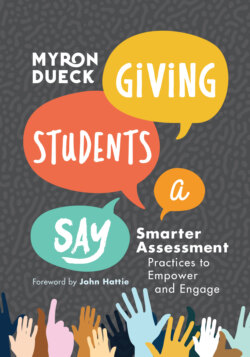Giving Students a Say

Реклама. ООО «ЛитРес», ИНН: 7719571260.
Оглавление
Myron Dueck. Giving Students a Say
Giving Students a Say
Table of Contents
ASCD Member Book / Also by the Author
Dedication
Foreword
Acknowledgments
The Elevator Pitch
Support for a Student-Centered Approach to Assessment
Voice and Choice: Key Factors in Student-Centered Assessment
The Power of Voice
The Importance of Choice
The Structure of This Book
Sharing and Cocreating Student-Centered Learning Targets
Learning Standards and Learning Targets: What's the Difference?
Learning Standards
Learning Targets
Figure 2.1. Unit Plan with Learning Targets
Three Flaws in the Traditional Approach to Learning Targets
Teacher-Centered
Copied from State or National Standards
Displayed but Not Implemented
Giving Students the "Inside Scoop" on Learning Targets
Actions (Verbs) and Content (Nouns)
Categories of Targets
Figure 2.2. Unit Plan for History 12: Paris Peace Conference
Student-Created Targets
Collective Student Efficacy and Cocreated Learning Targets
Figure 2.3. Chemistry and Geography Learning Targets
Learning Targets at the Elementary and Secondary Levels
Helping Elementary Students Understand Learning Targets
Figure 2.4. Elementary Unit Plan Template
Figure 2.5. Sloane's Equation
Figure 2.6. Completed Template for a Grade 3 Common Core Math Standard
Engaging Secondary Students with Learning Targets
Figure 2.7. Unit Plan for Beowulf
Closing Thoughts
Using Rubrics to Assess Performance
Rubrics: Why They Matter for Student-Centered Assessment
What Is a Rubric?
What Is the Purpose of a Rubric?
Figure 3.1. Types of Performances That Can Be Assessed with Rubrics
When Should I Use a Rubric?
Rubrics as a Tool for Teacher and Student
Benefits for Teachers
Learning Tools for Students
Holistic or Analytic? Deciding Which Type to Use
Figure 3.2. Holistic Rubric for a Scientific Revolution Project
Analytic Rubrics: A Closer Look
Criteria
Figure 3.3. Analytic Rubric for a Scientific Revolution Project
Fixed Measurement Scale
Figure 3.4. Zone of Potential Misclassification
Descriptors of Student Performance
Figure 3.5. Rubric for Designing a Planner Cover
Figure 3.6. Rubric with Student-Provided Descriptors
Seven Design Considerations
#1: Ensure That the Highest Level Can Be Modeled and Is Attainable
#2: Use Strength-Based Language at the Emerging Level
#3: Include Only Criteria That Are Linked to the Established Standards
#4: Avoid Quantitative Language
#5: Avoid Using Absolutes Such as All, None, Every, or Never
#6: Avoid Combining Multiple Variables in a Criterion Row
Figure 3.7. Rubric Combining Multiple Variables
#7: Ensure That Descriptors in the Same Row Describe the Same Characteristic
Figure 3.8. Rubric with Ambiguous Descriptors
Figure 3.9. Checklist for the Seven Design Considerations
Providing Examples
Walkabouts—An Innovative Assessment Tool in Need of a Rubric
A Secondary-Level Example
Figure 3.10. Analytic Rubric for a Secondary-Level Walkabout
An Elementary-Level Example
Figure 3.11. Analytic Rubric for an Elementary-Level Walkabout
How a Simple Rubric Transformed a Journaling Assignment
Figure 3.12. Rubric for a Leadership Journal
Closing Thoughts
Involving Students in Ongoing Assessment
Storage Strength Versus Retrieval Strength
Desirable Difficulties
Performance or Learning: What Are You After?
Self-Testing Versus Traditional Study Methods
The Hypercorrection Effect
New Systems for New Ideas
An Updated Retesting Structure
Figure 4.1. Cover Sheet for History 12 Unit Test
Figure 4.2. Unit Test Tracking Sheet for History 12
An Exemplary Self-Tracking and Pre-Test System
Figure 4.3. Self-Tracking Sheet for Math 9 Learning Goals
Student Self-Assessment and Self-Reporting in an IB High School
Closing Thoughts
Creating Fair and Sensible Grading Systems
Standards and Grades: Different but Related
A Pivotal Teacher-Student Conversation
Summerland Secondary and the Origins of the Six-Point Scale
Figure 5.1. The Barometer for the Influence of Homework
Problems with Percentages
The "Real World" Argument
The Verbs They Are A-Changin': Why Percentages May Not Work with Current Learning Targets
The Illusion of Precision
The Power of Zero
Figure 5.2. The Power of Zero
The Conversion Game
Rethinking the Value of Learning Ceilings
Figure 5.3. Student Rating Scale
Figure 5.4. ASFM Student Self-Progress Tracker
Innovation at the University Level
Closing Thoughts
Student Self-Reporting: "It's More Than Numbers"
Figure 6.1. Tom Brady's NFL Combine Spider Chart
The Impact of Context
The Power of Individual Perspective
Accuracy: The Elephant in the Room
Figure 6.2. Self-Report Form for Leadership Class
Sharing Circles: Opening the Door to Student Self-Reporting
Getting Started with Sharing Circles
Benefits of Sharing Beyond the Circle
Conversation-Based Grading
Figure 6.3. Proficiency Scale with Teacher and Student Language
Figure 6.4. Sources of Evidence
Figure 6.5. Percentages as Related to Rubric Categories and Levels
Figure 6.6. Self-Reporting Template for Learning Goals in Science 10
Figure 6.7. Drive-Thru Evaluation
Figure 6.8. Cafeteria Spider Chart
Getting Students to Embrace—and Talk About—Challenges
Self-Reporting of Behaviors, Effort, and Work Habits
Grade 2 Math Self-Evaluation
Figure 6.9. Math Grade 2 Report Summary
Secondary Student Self-Evaluation
Figure 6.10. Student Self-Evaluation: Responsibility, Regulation, and Collaboration
Self-Assessment Report Card Comments
Asking Students to Report on What's Not Obvious
Figure 6.11. My Learning: Above and Below the Surface
A Final Word on Student Self-Reporting
Conclusion
References
Study Guide
Foreword
Chapter 1. The Elevator Pitch
Chapter 2. Sharing and Cocreating Student-Centered Learning Targets
Chapter 3. Using Rubrics to Assess Performance
Chapter 4. Involving Students in Ongoing Assessment
Chapter 5. Creating Fair and Sensible Grading Systems
Chapter 6. Student Self-Reporting: "It's More Than Numbers"
Conclusion
Related ASCD Resources. Assessment and Grading
Print Products
PD Online
ASCD myTeachSource®
Whole Child
Whole Child Tenets
About the Author
Отрывок из книги
Smarter Assessment Practices to Empower and Engage
Myron Dueck
.....
I had a student, Sam (a pseudonym), who had made one tiny error on our unit test on the Paris Peace Conference and had lightheartedly demanded a retest, cheekily muttering that there was nothing I could ask him that he didn't know about our unit. "Just give me my inevitable 100 percent," he said. In reaction, I made his "retest" an interesting mission. He needed to find out something about our unit that I (1) didn't know and (2) would find intriguing. Furthermore, he needed to tell me when he was ready, and I'd choose the time and place for him to present his findings.
"How am I supposed to know what you'd find intriguing?" he asked with some frustration.
.....